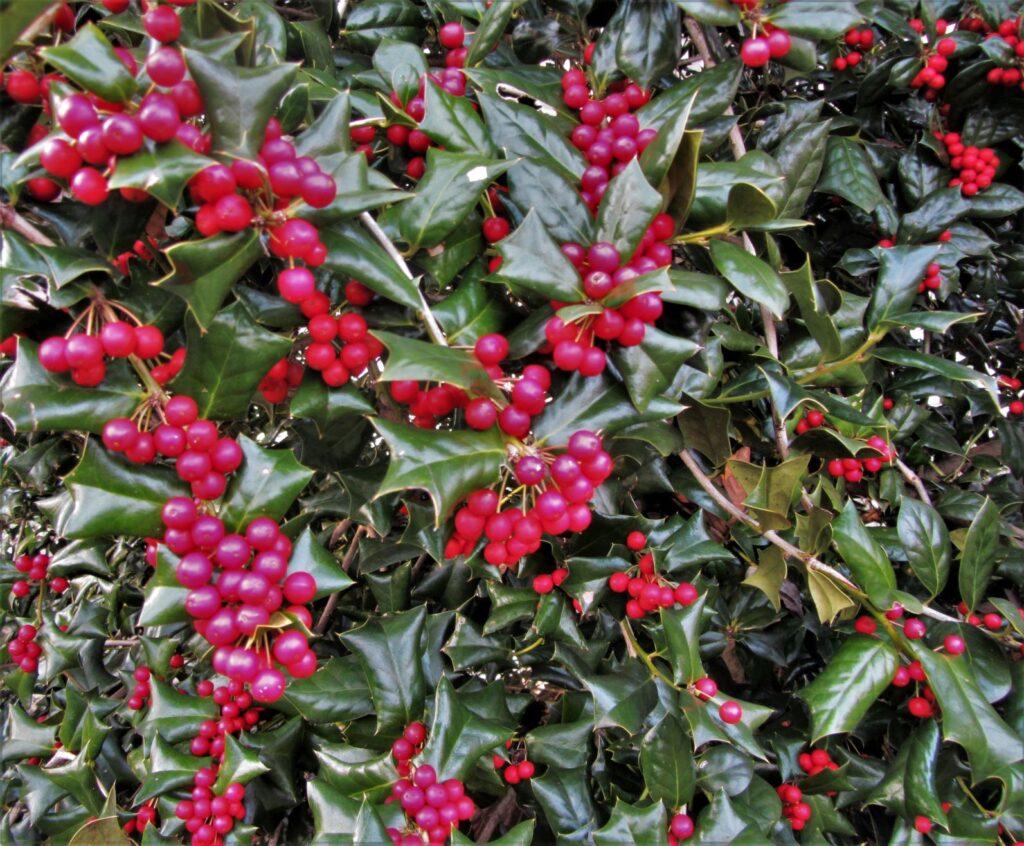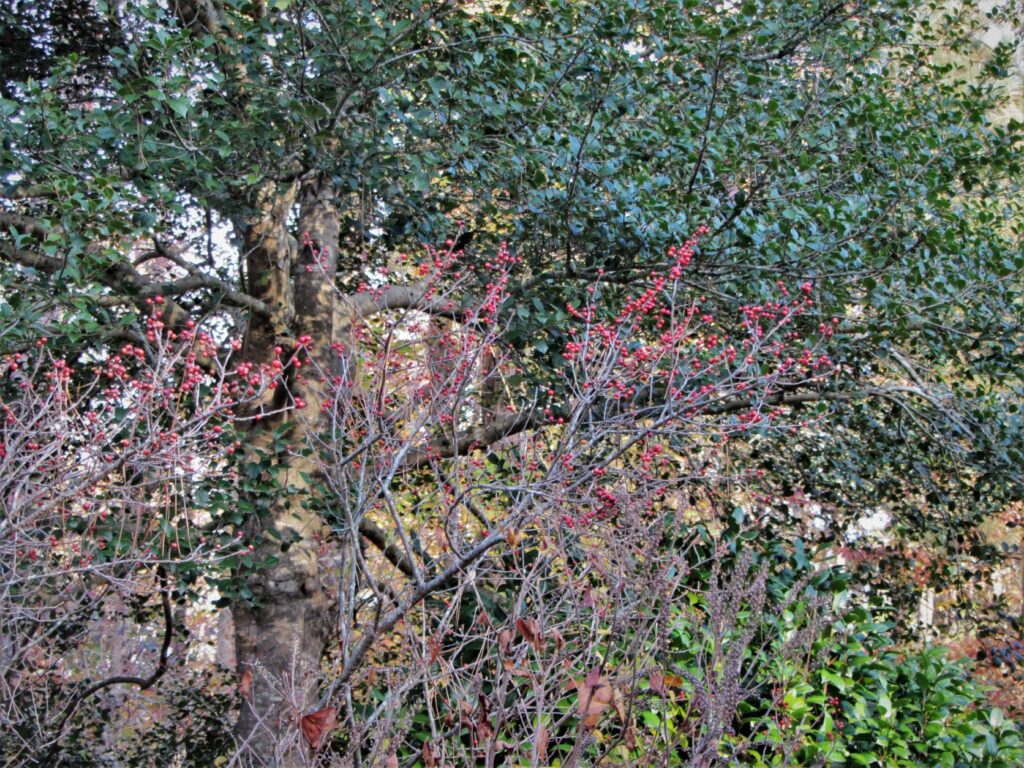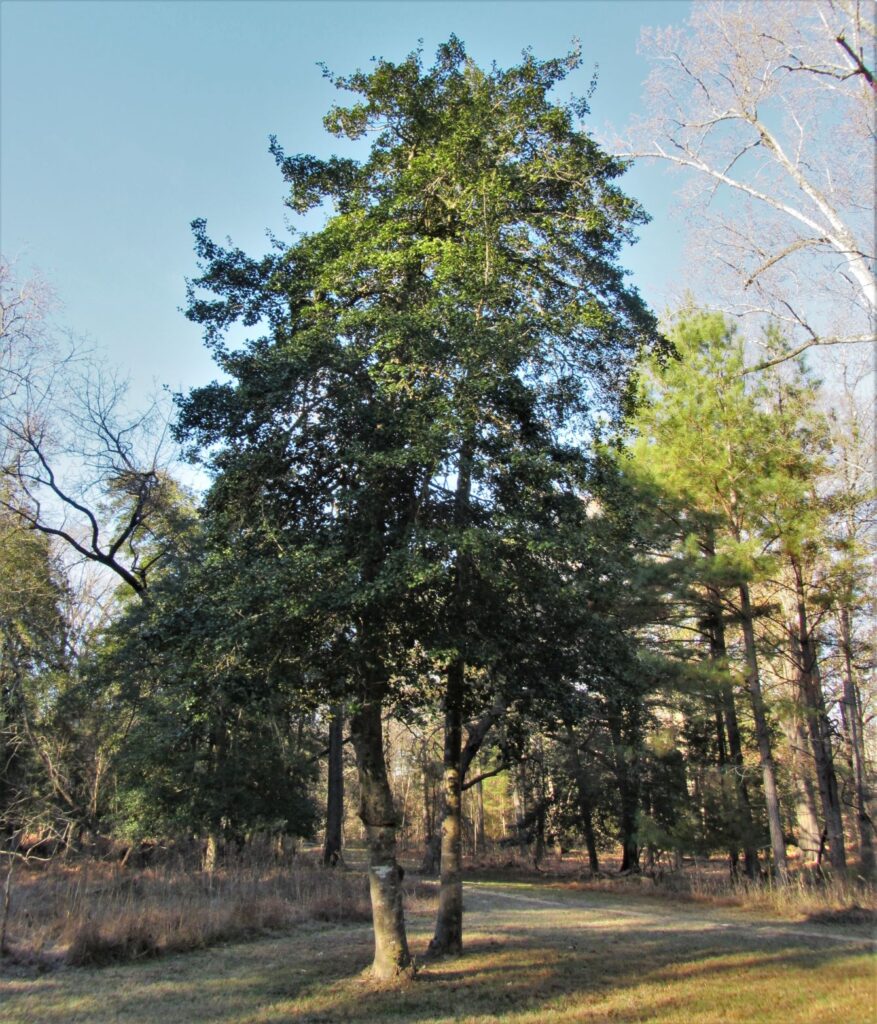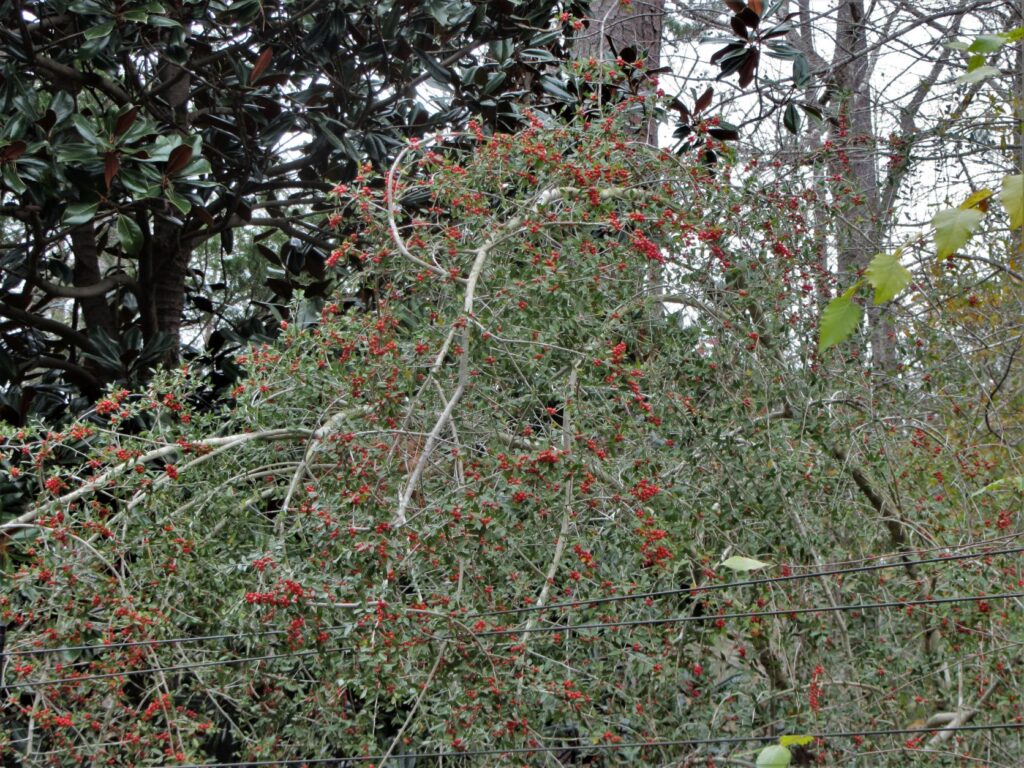Holly, King of the Winter Forest
In late autumn, the Williamsburg area woods light up with evergreen holly trees as the hardwoods lose their leaves. It is their time to sparkle in the winter sunshine. Their broad, prickly leaves are waxy on top, reflecting what light reaches them through the forest canopy. Unobtrusive throughout the summer, hollies are among the few forest trees, along with wax myrtle, pines, cedars, and magnolias, which remain bright green and covered in leaves throughout the year.
Holly King Legends and Lore
From pre-history until today, the Holly King rules the forest during the dark half of the year, coming to power in autumn and reining until his defeat by the Oak King in the spring. The Oak King rules the forest once its leaves return, defeating the holly for another year. These two ‘royal’ trees ruled the forests for those following ‘the old ways’ in European Celtic cultures.
At the time, holly was considered an evergreen oak, symbolizing eternal life and fertility. The genus name, Ilex, is Latin for the “holm oak”, or “evergreen oak.” It was well known and loved in Europe long before the first English colonists came to North American in the late 16th century and discovered our native North American holly species. Indigenous native Americans were already using native holly leaves and bark to brew medicinal teas. The berries, or drupes, were also used medicinally in some cultures.
The holly was considered a powerful tree of protection from evil, illness, and even from storms and lightning. Its wood was considered so holy that it was an ill omen to cut down a holly tree. Instead, the trees were coppiced, and berry laden branches pruned each winter.
Traditional Uses for Holly Wood
Branches brought indoors for decoration and protection also provided indoor dwellings for the fairies through the coldest winter months, assuring the good-will of the fae folk. It was considered bad luck to discard holly branches until spring. At the end of winter, dried holly branches were burned to prevent the fae from lingering in the home and causing mischief.
Coppiced holly stems were used to carve chess pieces and wands, to make handles for tools, and to fashion inlay designs for furniture because the white holly wood is so strong and fine grained. Ancient tree lore taught that holly had control over animals of all types, and so the handles of whips, staffs, and other tools for working with animals were made with holly. Holly wood was used in construction of Scottish bagpipes. Native Americans liked to use holly wood to make their tools and weapons. It is still favored today for its strength and beauty.
A ‘Holy’ Tree
Holly is a sacred tree to both ancient and modern Druids. It is one of the ‘holy trees’ of the Ogham Tree Alphabet, and is associated with Tinne or Teine, the letter T. Most people associate holly with the Winter Solstice, Yule, and Christmas, when it is brought indoors and used in holiday decorations. The holly’s red berries are symbolic of the sun, which returns in strength and length of day after the Winter Solstice on December 21 or 22 each year. The Romans believed holly to be sacred to the god Saturn, and so it was a part of their Saturnalia celebrations each December.
Holly is also associated with the lightning gods Thor and Taranis because holly, planted beside a building, was believed to protect it from lightning strikes. Modern research has shown that the prickles on the edges of holly leaves can dissipate electricity, so there is some truth to this lore. Holly was also supposed to give protection from illness, evil, and mischievous fairy folk.
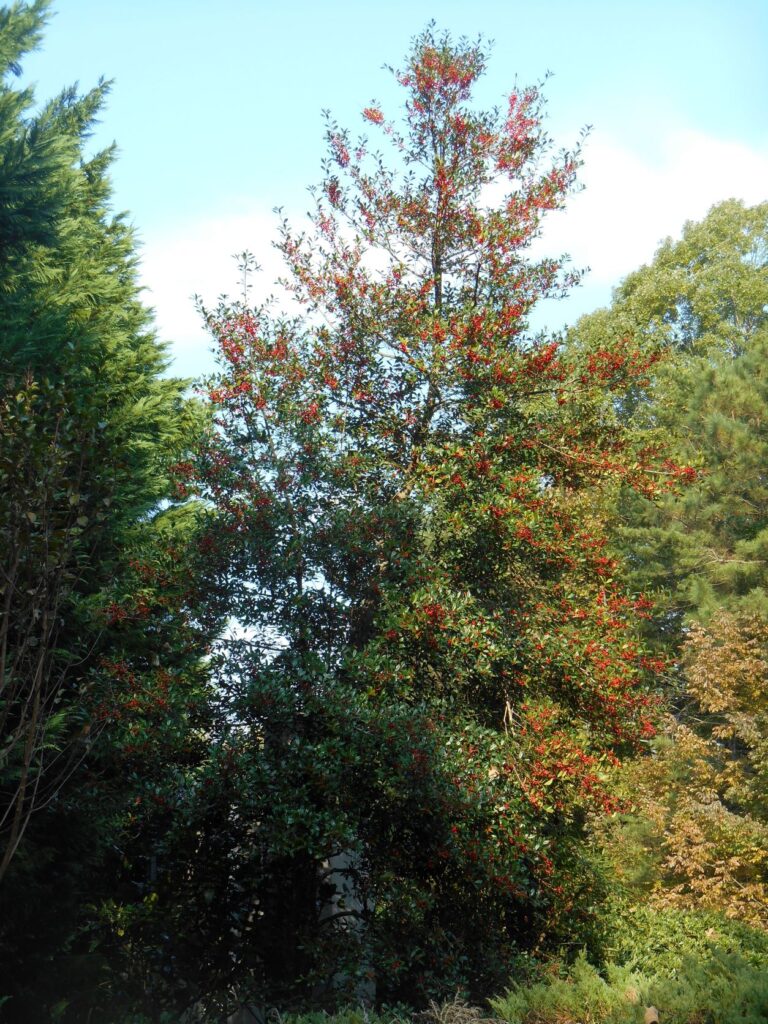
Foster holly grows into a slender, pyramidal shape and can produce berries without a male pollinator tree nearby.
Types of Holly
There are over 400 species of holly worldwide, growing in a variety of different climates. All female trees produce drupes in winter. Different species have different colored drupes, ranging from black, to orange, burgundy, red and white. Although most are evergreen, there are deciduous holly species, such as our native Ilex verticillata, or winterberry. Holly fruits are generally considered poisonous to people, especially if eaten in any quantity.
The American holly, I. opaca, is native along the Eastern seaboard in zones 5-9 from southern Connecticut south to Florida, and west into Eastern Texas. Our native holly is very slow growing, but eventually reaches 60′ tall and 20’ wide. Mature holly trees, growing where they can get full or partial sun are majestic, beautiful trees. George Washington, and other colonial Americans, admired American holly trees and planted them near their homes. Several trees planted by Washington survive today. Native hollies were among the many plants exported to Europe by the colonists.
I. vomitoria, or Yaupon holly, grows in the Southeast in Zones 7-9. Its leaves contain caffeine and were dried and used by Native Americans in a ceremonial tea. Leaves have smooth edges. Its species name is descriptive of the effect eating this holly’s leaves will have on people and animals. Some varieties grow as trees to more than 30’, while dwarf cultivars stay small enough to replace boxwood in landscaping.
Foster’s holly, I. x attenuata, is a natural hybrid of I. opaca and I. cassine first collected in Florida. I. cassine is native to the Southeastern United States and islands in the Caribbean in Zones 7-11. Foster’s holly fruits heavily without pollination. Its neat, pyramidal form to 30’ make it an excellent tree for yards and gardens. It grows more quickly than some hollies and will tolerate occasionally wet soil.

Dwarf Yaupon holly shrubs, I. vomitoria ‘Schelling’s Dwarf,’ make a neat planting that deer won’t touch. Chinese holly grows above them at the base of the sign, Foster’s holly grows to the left of the sign and a Berberis species, Oregon grape holly to the right, next to I. opaca. Holly is an easy to care for, reliable evergreen plant for landscapes.
English holly or European holly, I. aquifolium, also grows as an understory tree in hardwood forests throughout most of Europe, still often growing under oak trees. It is found in Canada and the Pacific Northwest most commonly in North America, but I. aquifolium will grow in many areas in Zones 5-9. to 50’ tall and 25’ wide. Many named cultivars, some variegated, are available on the market.
Chinese I. cornuta, and Japanese I. crenata are widely available in garden centers and both are frequently planted by developers and landscapers for their smaller size and easy care. Chinese holly can grow to 15’ in Zones 5-9 while Japanese holly, which looks a lot like boxwood with smooth edged smaller leaves, grows to around 10’ in Zones 5-8. Many named cultivars of both species are available. Japanese holly often has small black drupes, while I. cornuta has large, bright red drupes in abundance. These species feed pollinating insects and birds and can naturalize and hybridize in the landscape.
Holly will grow on a variety of soils, from moist swampy soil to very dry sandy soils. Some types are prone to root rot on wet soils, so choose carefully for wet areas. Although they prefer a slightly acidic soil, they can also grow in more neutral ground. Hollies grow extremely well with pines and oaks. As the pine needles and oak leaves decompose, they keep the soil rich and acidic.
Holly trees may be male or female, and only the female plants produce the drupes. Cross pollination is necessary for berry production, and female trees need a male nearby for pollination to occur. A general rule is to plant one male tree for every three female trees. The small, yellow green flowers which appear in the spring are an important source of nectar for bees and other nectar loving insects.

American holly was used medicinally as well as for its wood, by indigenous Native American cultures.
Hollies are loved by birds and other animals not only for their fruit, and important winter food source, but also for the shelter they provide. Their dense, prickly leaves offer protection in foul weather and are favored nesting sites. Birds spread holly seeds in their droppings. One often sees whole groves of small holly trees growing in the winter woods, all volunteers growing from bird sown seeds. Holly seeds usually need to pass through a bird’s system to break down their seed coat for germination to occur. Growers may treat holly seeds with an acid bath to get them to germinate.
You might expect thorny holly leaves to be ‘deer resistant.’ Holly leaves are very nutritious and were cut up and used as winter animal feed in Europe. Deer may graze some holly varieties, particularly newly planted hybrids. Nitrogen fertilizers make the leaves ‘salty’ and appealing to wildlife. Even young I. opaca shrubs may be grazed. I. vomitoria is reliably deer resistant because its leaves cause stomach upset.

Holly is difficult to grow from seeds. Most native trees were planted by the birds. Deer may graze young plants, and those hybrids purchased from a nursery.
Holly is an excellent shrub or tree in yards, gardens, and naturalized areas. Their evergreen leaves and bright red berries make them favorite winter ornamental plants. Many will limb-up hollies in their yards, once they reach 10′ or more, to grow them as standard trees. Most hollies can be pruned and shaped very easily and grown as a hedge. Pruning is often done in early December so the branches can be used decoratively during the holidays.
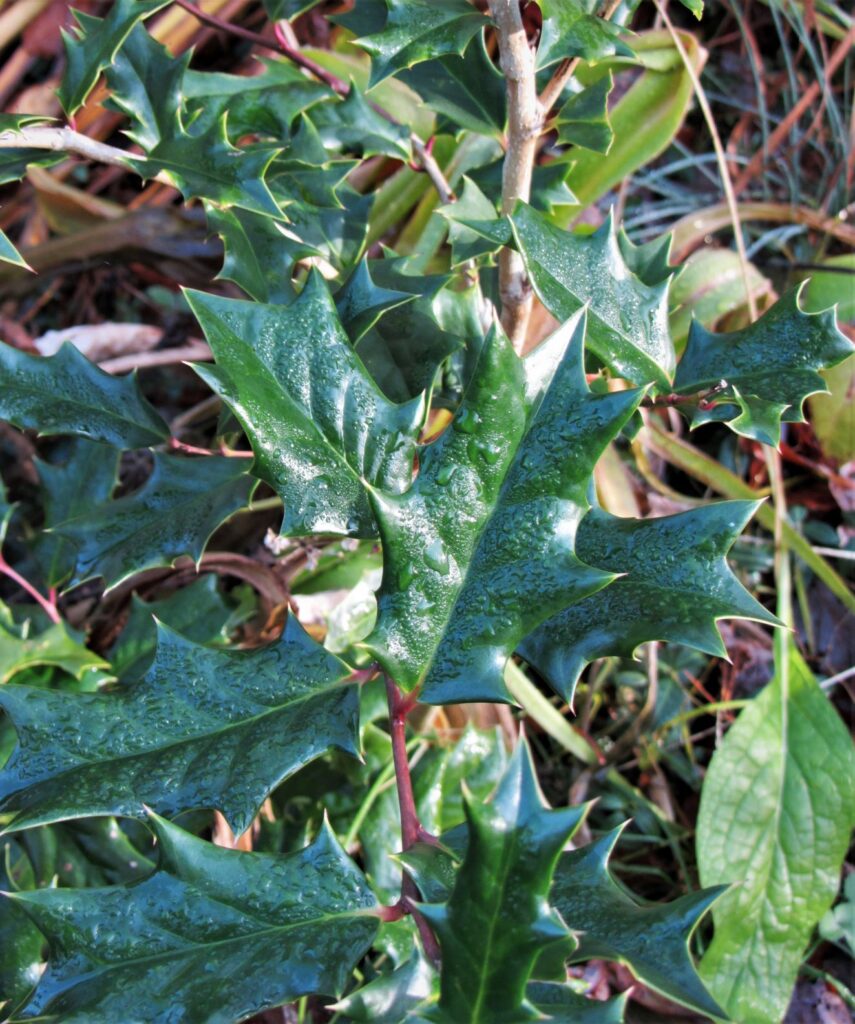
This unknown avian planted seedling probably has Chinese holly in its DNA because of its sharp, glossy leaves.
Not only is holly a beautiful plant, it also offers food and shelter for wildlife, makes a good windbreak, provides shade, and is an extremely tough and tolerant plant once established. Whenever I see little holly seedlings cropping up, I protect them and let them grow in hopes that my front garden will one day sparkle and shine in the winter sunlight, full of legendary hollies.
All Photos by E. L. McCoy



